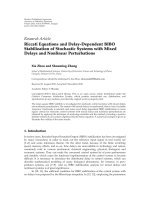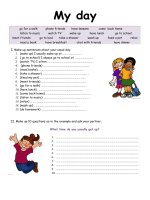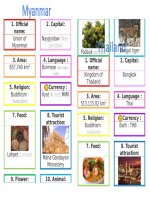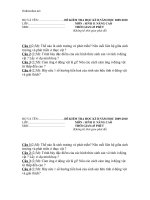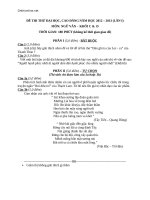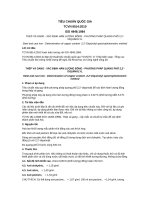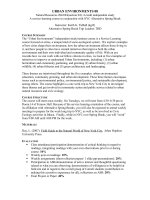- Trang chủ >>
- Đề thi >>
- Đề thi lớp 1
4946
Bạn đang xem bản rút gọn của tài liệu. Xem và tải ngay bản đầy đủ của tài liệu tại đây (633.41 KB, 6 trang )
12-Jul-19
Nature of Trading Businesses
Chapter 5
Would you please tell me three most common
type of businesses?
Accounting for
Trading Business
Manufacturing
Services
Trading
Objectives
Nature of Trading Businesses
Distinguish the activities of a service business from those of a
Which type of business has the most complex
trading business
accounting system?
Journalise the entries for trading transactions
Prepare a profit and loss statement for a trading business
Contents
1. Nature of Trading Businesses
2. Accounting for Purchases
3. Accounting for Sales
4. Trade Discounts
5. Transportation Costs
6. Profit and loss statement for a trading
business
Manufacturing
Nature of Trading Businesses
Why?
Service Business
Fees
X
Expenses
(X)
Net Profit
X
Trading Business
Sales
COGS
Gross Profit
Operate Expenses
Net Profit
X
(X)
X
(X)
X
COGS in a manufacturing business: Material, Labour and
Overhead
1
12-Jul-19
Nature of Trading Businesses
Accounting for Purchases
2. Periodic Inventory System
COGS
Purchase
Goods
Re-sale
Inventory is accounted for at the end of the period
COGS = Opening Balance + Purchase – Closing Balance
Goods on hand at the end of the month or the
year (Inventory)
Accounting for Purchases
1. Perpetual Inventory System
2. Periodic Inventory System
3. Purchase
Stocktaking
Accounting for Purchases
3. Purchase
Could be made:
4. Purchases discounts
- By Cash
5. Purchases Returns and Allowances
- On Credit
- By Mixture (Cash + Credit)
Accounting for Purchases
1. Perpetual Inventory System
Each purchase and sale of goods is recorded in an
Inventory Account. The amount of goods available for
sale and the amount sold are continuously (perpetually)
shown in the inventory records.
Accounting for Purchases
Purchase by Cash
Debit Inventory
Credit Cash
Purchase on Credit
Debit Inventory
Credit Trade Payable
Closing Balance = Opening Balance + Purchase - Sale
Purchase on Mixture
Debit Inventory
Credit Cash
Credit Trade Payable
2
12-Jul-19
Accounting for Purchases
Purchase discounts: reduced amount when making early
payment
Credit terms: Terms for when payments for goods are to be
made
Not allowed an amount of time to pay: Cash or Net Cash
Allowed an amount of time to pay: Credit
Credit period: Amount of time allowed before a payment is
required (begin with the date of the sale as shown on the
invoice) (30 days, 45 days, 90 days, etc)
Accounting for Purchases
5. Purchases Returns and Allowances
Debit Trade Payable
Credit Purchases Returns and Allowances
When goods are returned or price is adjusted,
buyer usually sends the seller a letter – called
debit note or debit memorandum
Accounting for Purchases
Accounting for Sales
Credit terms: Cash or Credit
1. Sales
Could be express:
n/30
n/eom
2/10
2. Sales Discounts
3. Sales Returns and Allowances
4. Goods and Services Tax
5. Trade Discounts
Could use more than 1 term together
2/10, n/30
Accounting for Purchases
4.
Purchases discounts
Purchase good (assume on credit)
Debit Purchase
Credit Trade Payable
When making early payment (enjoy purchases discounts)
Debit Trade Payable
Credit Cash/Bank Account
Purchases Discounts
Accounting for Sales
1. Sales:
Could be made:
- By Cash
- On Account
- By Mixture (Cash + Credit)
Note: These discounts reduce the cost of the goods purchased
3
12-Jul-19
Accounting for Sales
Accounting for Sales
Sales by Cash
2. Sales Discount
Debit Cash
Credit Sales/Sales Revenue
Debit Cash
Debit Sales Discounts
Credit Account Receivable
Sales on Account
Debit Trade Receivable
Credit Sales/Sales Revenue
Sales on Mixture
Debit Trade Receivable
Debit Cash
Credit Sales/Sales Revenue
Accounting for Sales
Accounting for Sales
Sales made with the use of credit cards? (Master cards, VISA,
3.
etc)
Will create a receivable with the card companies. These
companies will charge a service fee.
Sales on credit cards:
Debit Account Receivable (Card Company)
Credit Sales
Receive money from card company:
Debit Cash
Debit Credit Card Expenses
Credit Account Receivable (Card Company)
Sales Returns and Allowances
Goods sold be returned to seller (sales return)
The seller may reduce the initial price because of defects
(sales allowance)
The seller usually issues the buyer a credit note or credit
memorandum
This will reduce sales. However, manager may want to know
the amount of returns and allowances for a month or a year
open contra sales accounts
Accounting for Sales
2. Sales Discounts
Accounting for Sales
4. Goods and ServicesTax (GST)
Seller may offer the buyer credit terms that include
a discount for early payment.
In some countries, this type of tax could be also
known under the name Value Added Tax (VAT)
In theory, discount for early payment will reduce
Sales/Sales Revenues (Debit it!!!). However,
managers may want to know the amount of sales
discount for the period Open Sales Discounts
Account (Contra Sales Account)
Businesses are authorised to charge and collect GST
(or VAT) on behalf of the Controller of GST (Tax
Authority)
4
12-Jul-19
Accounting for Sales
Transportation Costs
4. Goods and Services Tax (GST)
Sale is determined when ownership (title) of the
In some countries, this type of tax could be also known
under the name Value Added Tax (VAT)
good passes to the buyer.
GST Payable (When sale is made)
GST Receivable (When purchase is made)
At the end of each quarter, business pays the net amount of
tax (ie GST Payable – GST Receivable)
Trade Discounts
This point determines which party (buyer or
seller) must pay the transportation costs.
Transportation Costs
Businesses may offer special discounts for large quantities
Buyer Pays
Shipping
Point
FOB (Free On Board)
Destination
Seller Pays
Trade Discounts
Transportation Costs
Sellers and buyers do not normally record the list
FOB Shiping point
prices of goods and the related trade discounts in
their accounts.
In order words, the recorded amount is already
reflected the trade discount.
Debit Transportation In
Credit Cash/Bank/Payable
Buyer
FOB Destination
Debit Transportation Out
Credit Cash/Bank/Payable
Seller
5
12-Jul-19
Profit and loss statement for a trading
business
Revenue from Sales
X
Cost of Goods Sold
(X)
Gross Profit
X
Other Revenue
X
Operating Expenses
Net Profit
(X)
X
6
